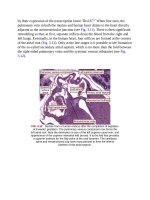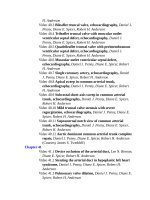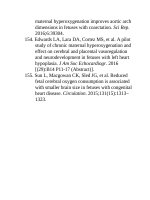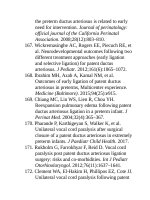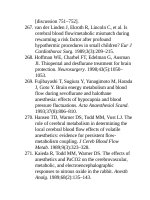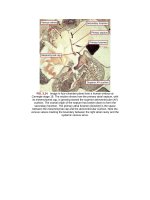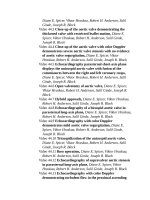Andersons pediatric cardiology 1092
Bạn đang xem bản rút gọn của tài liệu. Xem và tải ngay bản đầy đủ của tài liệu tại đây (148.48 KB, 3 trang )
FIG.41.20 Movatpentachromestainingofthearterialduct(×400
magnification).Upperrightpanelshowsthespontaneouslycontractedduct
in7-day-oldpiglet.Upperleftpanelshowstheduct,stentedwithabare
metalstentandimmediatelyharvested.Lowerpanelsshowexamplesof
stentedductsrepresentativeofthebareanddrug-elutingstentgroups.
Notethatthereisnegligibledifferenceinlumenpatencybetweenthedrugelutingstentandbaremetalstentat2weeksbutincreasedluminal
compromiseinthebaremetalstentgroupat4and6weekscomparedwith
thedrug-elutingstent.
BioengineeringoftheArterialDuctfor
TherapeuticGain
Novelmethodologyisemergingformaintainingductalpatencyintothe
postnatalperiodtosustainlifeandallowsurgicalinterventionofduct-dependent
cardiacmalformations.Maintenanceofductalpatencyhasbeendescribed
throughsurgicaltransfectionoffetallambs219;bytargetingtheductalsmooth
musclecellswithanexpressionvectorencodinga“decoy”mRNAofthe
fibronectinmessage,itprovedpossibletosequestertheproteinitbinds,thereby
preventingupregulationoffibronectinandarrestingintimalcushions.This
approachemphasizesboththeimportanceoffibronectintotheprocessofductal
closureandidentifiesanewtherapeuticmodalityandtarget.Althoughfetal
surgeryislikelynotfeasibleintheclinicalsetting,analternativeapproachof
targetingchemotherapeuticagentsgivenbysystemicinfusiontodifferent
vascularbedsbyuniquepeptide“zipcodes”mayofferbrighttherapeutic
avenues.220Humplandcolleaguesinvestigatedpercutaneouspostnatal
transfectionofavectorcontainingthegeneforprostaglandinintoductaltissue,
resultinginprolongedpatency.221
Thesestudiesidentifyingandcharacterizingthecellularandmolecular
mechanismsinvolvedinductalpatencyandclosurehaveadvancedour
understandingofthisdevelopmentallyprogrammedfetalvessel.Theimpactof
theseadvancesextendsbeyondthescopeofductalremodelingbecausethey
haveprovidedinsightintothepathogenesisofocclusivevasculardiseases,
processesthatusesimilarpathways.Thisworkhasalsopositionedthefield
towardfurtheradvancesassociatedwiththedevelopmentofsafetherapeutic
measurestomaintainductalpatencyforinfantswithcyanoticcongenitalheart
disease,ultimatelytranslatingintoimprovedcareandclinicaloutcome.
AnnotatedReferences
GrossRE,HubbardJP.Surgicalligationofapatent
ductusarteriosus.Areportoffirstsuccessful
case.JAMA.1939;112:729–731.
Thislandmarkreportusheredintheeraof
correctivesurgeryforcongenitalheartlesions.
Aninterestingirony,thatitwasmanagementof
thearterialductbytranscatheterapproaches
thatalsoestablishedminimallyinvasive
managementofcongenitalheartlesions.
TynanM.Themurmurofthepersistentlypatent
arterialduct,or“thecolonelisgoingtoa
dance”.CardiolYoung.2003;13:559–562.
Dr.Tynanremindsusofthehistoryoftheclinical
recognitionofthearterialductbyGibsonand
theimportanceofconfirmingoursources.
CoceaniF,OlleyPM.Theresponseoftheductus
arteriosustoprostaglandins.CanJPhysiol
Pharmacol.1973;51:220–225.
Thislandmarkpaperwasfirsttodescribethe
actionsofprostaglandinsonthearterialduct.
Althoughtheoriginalhypothesiswasthat
prostaglandinleadstoductalconstriction,these
investigatorsexperimentalfindingsbecamethe
underpinningfortheunderstandingofthe
